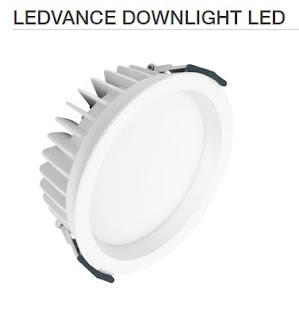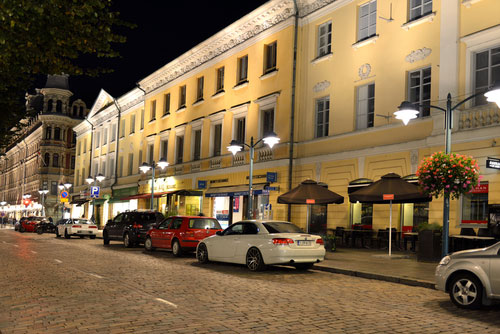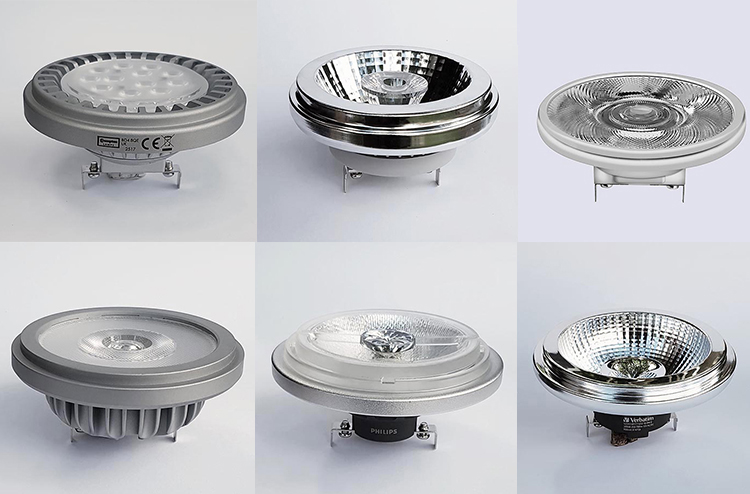Archive for August 2017
We now have on-shelf stock of new LEDVance LED Downlight from Osram in all 3 outputs: 14W, 25W, and 35W.
Product benefits
- High luminous efficacy
- Direct replacement for compact fluorescent lamp downlights
- Energy savings up to 60 % (compared to luminaires that use CFL lamps)
- Very homogenous light
- Functional design
- Easy installation with fast connection
- External driver for extended flexibility (compatible with selected DALI drivers)
Areas of application
- Direct replacement for luminaires with compact fluorescent lamps
- General illumination
- Public areas
- Stairways
- Corridors
- Foyers
- Shops
Product features
- Diameter of required ceiling cut-out: 150 mm or 200 mm (depending on version)
- Type of protection: IP20
4058075000001 · 4058075000025 · 4058075000049 · 4058075000063 · 4058075000087 · 4058075000100 · 4058075016323 · 4058075016347 · 4058075016361 · ledvance downlight · Novel Energy Lighting · osram led · osram ledvance
4
Helsinki’s smart street lights will find you a parking place
Comments off · Posted by admin in LED, Philips LED
THE CITY of Helsinki has installed internet-connected street lights which find motorists a parking place.
The pilot deployment uses miniature Internet-Protocol video cameras mounted on the luminaires to monitor the spaces. These cameras generate data which is interpreted by cloud-based image analytics to assess if the parking space is available. This real-time parking occupancy information can then be pushed to city authorities and motorists. Additionally, this data can be shared with third-party app developers.

A micro camera from Super Circuits similar to the ones deployed in the Helsinki smart parking experiment. The increasing miniaturisation of video cameras means they can easily be incorporated in both outdoor and indoor lighting. Manufacturers say that as prices fall, they could replace passive infra-devices so that, for instance, instead of knowing if a meeting room is occupied, as a PIR can detect, a video camera could be used to determine exactly how many people are present.
It’s also part of a wider programme in which the Public Works Department of the City of Helsinki is considering using public lighting as a potential backbone for Internet of Things services.
Parking is considered a potential killer app for so-called smart cities. Studies in San Francisco have shown that 30 per cent of the traffic congestion in cities is caused by drivers spending time searching for a parking spot, so reducing this time can lower air pollution and traffic noise. Additionally, knowing the location and quantity of parking spaces can help cities cut down on illegal parking and develop a dynamic pricing structure based on use and occupancy data.
Continuous tracking of parking spaces also helps identify parking bottlenecks and offers a means to enable traffic guidance. In the future, outdoor luminaires could provide light indications, making it easy to identify open parking places on city streets.
Philips says the initiative has provided Helsinki with first-hand information about the suitability of video technology for smart parking and helped the city gain valuable insights into how this type of monitoring can be deployed. The company estimates that lighting-based parking management can reduce average parking search time by 40 per cent, reduces average traffic in terms of miles per day by 30 per cent and improve safety by reducing parking spot searches.
The lighting industry sees huge potential in street lighting becoming the digital backbone of smart cities. Trials are currently being conducted into the use of public luminaires to deliver Wi-Fi as well as monitor the use of firearms and the levels of snow.
See LED street lighting at Novel Energy Lighting
dynamic smart parking · Helsinki · led street lights · Novel Energy Lighting · philips lighting · smart cities · smart street lights
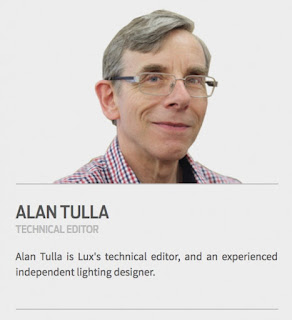
Lux reports: These LED retrofits are designed as energy saving replacements for the original tungsten halogen filament lamps. The AR111 filament lamp is usually 12V and, unsurprisingly, 111 mm diameter.
The lamps reviewed here are designed specifically as retrofit. I.e. they have an integral driver in the base. There are some LED AR111 suppliers whose lamp is only supplied suitable for luminaires with a dedicated, remote driver.
The reason for developing a large diameter reflector lamp was to achieve a tightly controlled beam which could be used for display lighting. Having a 12V filament meant you had almost a “point source” in terms of optics.
These LED replacements, therefore, need to have a good quality beam (no hot spots or striations) and excellent colour rendering. All the lamps have a CRI >80. We asked for lamps with a beam between 20° and 40°. Display lighting often requires a very narrow beam and you should check what is available from the manufacturer.
When we refer to a beam angle, we mean the total width at which the intensity is half the peak. E.g. a 40° beam is a cone of 20° around the central axis. Some manufacturers quote the angle either side of the axis. This makes the beam seem to be half the width it actually is. Labelling regulations say that the packaging should quote the lumen value inside a 90° cone. This is known as ‘useful luminous flux’ and should be marked on the box.
In order to test the colour quality, we sent the lamps to the laboratories at University College London for independent testing and comparison. Thanks go to Peter Raynham, the course director of the MSc in Light and Lighting and Janine Stampfli, the MSc student who conducted the testing.
The LED lamps were compared with a 75W AR111 halogen filament lamp and the CIE CRI and TM-30 Indices.
One final point: you need to check that the retrofit lamp will physically fit inside the luminaire. There have been some cases where the LED version is too large – this is often caused by the size of the heatsink.
Summary
It is interesting to see that the CIE CRI Ra which is based on eight pastel colours gave a good indication of colour rendering compared with the much more detailed and informative IES TM-30 which is based on 99 colours of all shades and saturation.
The Colour Vector Graphic is much more useful because you can easily see the deficiencies and strengths compared with the reference source even though it doesn’t have any numbers attached to it.
One last point that is often forgotten is that the only reason incandescent lamps have a CRI of 100 because they are also used as the reference source. Apart from its familiarity, you wouldn’t really want a light source so deficient at the blue end of the spectrum.

Crompton
This lamp has a nice looking beam with soft edges. Like another of the lamps reviewed, about 8% of the light falls outside a 90° cone. This means you get a bright centre with extra light for the ambient surroundings.
In appearance, there is an attractive outer rim with cooling “ribs/fins”. This spoilt somewhat by the central frosted plastic moulding where the 12 yellow LED chips can clearly be seen.
- Lux rating:
3 STARS

LEDVANCE
This Osram lamp from LEDVANCE most probably gives the nicest beam. It is uniform from the centre to the edge with no sharp cut-off.
The aluminium reflector is quite shallow and, like the other lamps, has diamond shape facets. The front of the lamp is completely sealed by a clear plastic lens. This has the advantage that the reflector would stay clean throughout its life.
- Lux rating:
5 STARS

Megaman LED Reflector
This has a facetted aluminium reflector with a clear prismed plastic cone in the centre to direct the light.
We tested the 48° version and the centre of the beam is nice and clean. However, the overall beam is very wide with 15% of the lumens being emitted outside 90°.
- Lux rating:
3 STARS

Philips Master LEDspot
This is a nice looking lamp and the front face looks almost exactly like the filament version. The concave reflector looks metallic although it is actually heavily prismed clear plastic. There is also a clear conical prism directly above the light source.
The beam is uniform from centre to the edge and there is only the slightest wooliness to the cut-off.
- Lux rating:5 STARS

Soraa Vivid
When I asked one well-known lighting designer which AR111 she specifies, she simply said “Oh, I just go straight to the top and specify Soraa”.
One aspect of Soraa lamps that designers particularly like is the range of snap on lenses. These can be used to adjust the beam width or change the colour temperature, CCT and can be done easily even after installation. If the layout of the shop changes, you can simply use another snap on lens.
- Lux rating:5 STARS
Verbatim
 As mentioned in the introduction, you need to check that the retrofit LED lamp will physically fit the luminaire. Verbatim are proud of their optimised thermal design which means it is shallower in depth than many other lamps.
As mentioned in the introduction, you need to check that the retrofit LED lamp will physically fit the luminaire. Verbatim are proud of their optimised thermal design which means it is shallower in depth than many other lamps.
It is also the most realistic looking lamp. There is no front cover, the reflector is all aluminium and there are no plastic mouldings in the centre. The beam is also good with no unevenness.
- Lux rating:
5 STARS
Test results
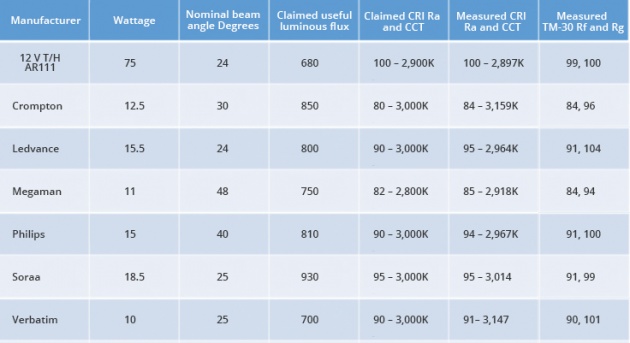
Visit Novel Energy Lighting to buy these brands of LED AR111 at very competitive prices!
crompton led ar111 · LED AR111 · megaman led ar111 · Novel Energy Lighting · osram ledvance led ar111 · philips masterled ar111 · soraa led ar111 · verbatim led ar111

